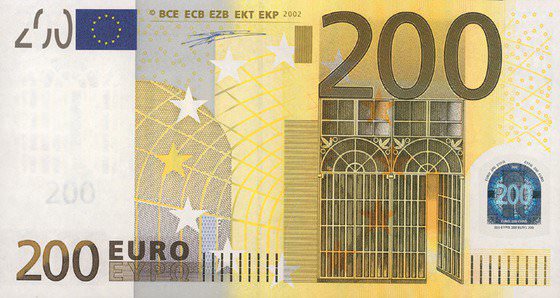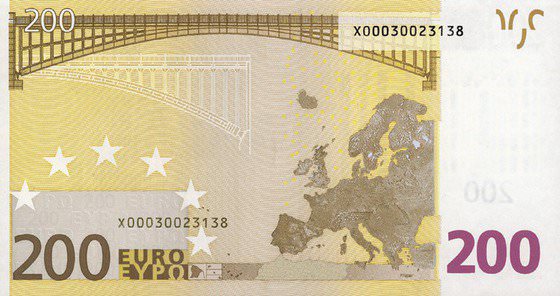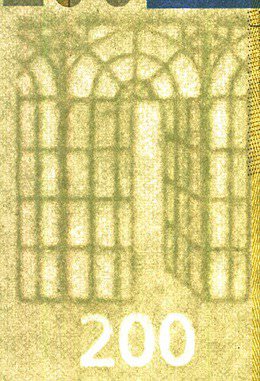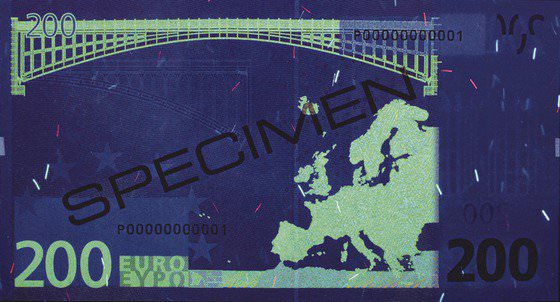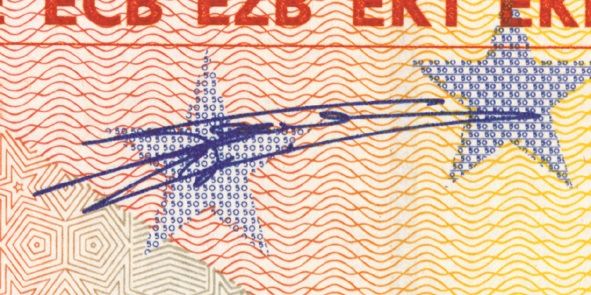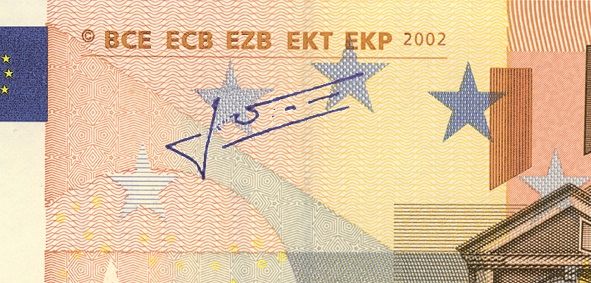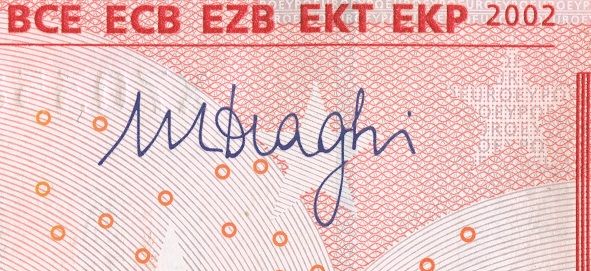
200 euros, Series of 2002
| Issuing authority: | European Central Bank |
|---|---|
| In circulation since: | 2002 |
| Substrate: |
Paper: has a light yellow shade, localized watermarks in the wide graphicless area and a digital watermark in the printed area; polymer demetalized security thread (embedded in paper) with text; colorless security fibers. |
| Dimensions: | 153mm × 82mm |
| Face: | Fragment of iron and glass architecture – modern 20th century |
| Back: | Steel bridge and map of Europe |
Detected counterfeits
| Date of detection | Currency name | Denomination | Alphanumeric code |
|---|---|---|---|
| 2010-02-11 | Euro | 200 | P00540566296, код предприятия-изготовителя T001F3 |
Intaglio: face (top) - copyright symbol, relief «© BCE ECB EZB EKT EKP 2002» (felt tactualy); large "200" on the right (top); main motif with magnetic properties (right half); bottom of the motif (including "200" in the left corner) is printed using two-color intaglio with the Orloff effect. Feature for the visually impaired is located in the right top and bottom parts of the banknotes and is a set of raised dotted lines.
Offset: face - grey printed area with background patterns and graphics including the EU flag and ECB president's signature. Back: all graphic elements except for the serial numbers.
Letterpress: back - 11-digit serial numbers with a letter prefix: dark brown inks on the bottom left; black magnetic inks on the top right.
View under UV light
In paper: colorless fibers chaotically spread over the banknote surface have red, blue, and green luminescence; paper has no luminescence under UV light.
Graphic elements: face - EU flag, ECB president's signature, and other elements printed with blue inks have green luminescence; all elements printed with yellow inks have orange luminescence; contour of the kinegram on the back has blue luminescence; images printed with dark brown inks (map of Europe, bridge, etc) have yellow luminescence.
View under IR light
Main image on the face is printed with IR metameric inks: right half of the image is visible under IR light, while the left is transparent.
Magnetic protection
Right half of the image on the face visible under IR light has magnetic properties.
Banknote design
All the banknotes of the European Central Bank are made in a single design style.
Architectural styles of various historical periods of the European states – from Roman to modern ones – were chosen for the main motif of the face.
The face of the banknotes also contains: EU banner; ECB abbreviation in five languages; year of the banknote in circulation; name of the currency in Latin and Greek; two full denominations and one partial denomination in the upper left corner of the empty space; multicoloured background picture with EU stars, facsimile signature of the Bank’s president at the top under the ECB abbreviation in five languages. In 1998-2003 this post was occupied by Willem Duisenberg, from November 1, 2003 Jean-Claude Trichet succeeded him, from November 1, 2011 Mario Draghi became ECB president. Banknotes signed by Willem Duisenberg (Fig.1), Jean-Claude Trichet (Fig.2), and Mario Draghi (Fig.3) are equally legal tender.
The manufacturer’s code is printed by offset on the painted area of the face. First letter designates the manufacturer of the banknote.
| D | Setec Oy (Finland) | L | Banque de France (France) |
| E | Francois Charles Oberthur Fiduciaire (France) | M | Fabrica Nacional de Moneda y Timbre (Spain) |
| F | Osterreichische Banknoten und Sicherheitsdruck GmbH (Austria) | N | Bank of Greece (Greece) |
| G | Johan Enschede en Zonen (The Netherlands) | P | Giesecke & Devrient (Germany) |
| H | De La Rue (UK) | R | Bundesdruckerei (Germany) |
| J | Banca d’Italia (Italy) | T | Banque Nationale de Belgique (Belgium) |
| K | Central Bank of Ireland (Ireland) | U | Valora (Portugal) |
On the back of all the notes bridges typical for various epochs were depicted.
Besides, the design contains three images of denominations and a partial denomination of the empty space, name of the currency in Latin and Greek; fragment of pseudo-relief contour grid with text “EUROEYRΩ”; multicoloured background picture with EU stars; two serial numbers, one of which obtains magnetic properties.
The serial number consists of eleven digits and two-letter prefix. The literal prefix corresponds to the country whose national bank issued the given banknote.
Luxembourg was assigned the letter “R”, but no banknote with the serial number started from this letter was issued. Some letters were assigned to the EU country-members that did not adopt euro as their currency – Denmark, Sweden, UK. The rest are reserved for the future.
| Z | Belgium | U | France | P | The Netherlands |
| Y | Greece | T | Ireland | N | Austria |
| X | Germany | S | Italy | M | Portugal |
| V | Spain | R | Luxembourg | L | Finland |
| H | Slovenia | G | Cyprus | F | Malta |
| E | Slovakia | D | Estonia |
Note: There is a clear consistency between letters and digits in the euro serial number. It is calculated so that the letter of prefix is changed to the number equal to numeric order of this letter in Latin alphabet (A - 1, B – 2… Z – 26). Then this number and all the digits of the serial number add until the result is a simple number. As a result of these mathematical operations with serial number of a genuine note one should get “8”. Let’s take as an example €50 banknote with serial number “X04017624905”. The letter “X” has numeric order 24 in English alphabet – (24+0+4+0+1+7+6+2+4+9+0+5=62; 6+2=8). So, the result is 8.
Paper
Paper is made using cotton fiber, toned (with each denomination having its own colour tone), strong, has a characteristic crackle.
Three types of coloureless fibers are embedded into the paper.
Watermark
On a wider empty area there is a local multitoned watermark – a fragment of the main motif of the face, as well as an electrotype light digital denomination.
Second watermark (coded) as parallel vertical contrast light stripes is situated in the left part of the face.
Structure, size and number of vertical stripes of the coded watermark are unique for each denomination. A continuous polymer security thread with direct and inverted demettallized text “EURO” and denomination is embedded into the paper and obtains machine-readable properties.
All the banknotes are printed according to the same method: multicoloured intaglio with Orlov print on the face, multicoloured offset with iris print both on the face and on the back. Two-colour letterpress of both eleven-digit serial numbers.
Security features
On a narrow empty area of the face of €5, €10, and €20 a stripe kinegram is embossed which contains multidimensional images of euro graphic symbol, digital denomination, rings of 12 EU stars, demetallized text “EUROEYRΩ” (for €5) and “EUROEYRΩ” (for €10 and €20), and positive digital denominations, as well as overprint of line intaglio picture “EURO EYRΩ”. On a narrow empty area of the face of €50, €100, €200, and €500 a local kinegram is embossed which contains multidimensional image of the main motif of the face, denomination and a system of rings, lines of which are formed by macro- and microtexts “EUROEYRΩ”.
The kinegram is strengthened by a demetallized picture of euro graphic symbol and positive text “EUROEYRΩ” along the perimeter.
Special security features of the banknote include: iridescent ink (transparent pearl with metallic shine) in the wide stripe with euro symbol and negative denomination on the back of €5, €10, and €20 (visible under reflected light); OVI ink in denomination on the back of €50, €100, €200, and €500; luminous color in inks, security fibers and some fragments of pictures, metameric inks, magnetic inks (the right side of the main motif on the face, security thread and black upper eleven-digit serial number with literal prefix on the back), microprint, anti-copy grids, micro patterns and the so-called “Eurion constellation” – a continuous pattern of five small rings that helps some types of copiers to detect the banknotes and block their operation.
All banknotes of the series